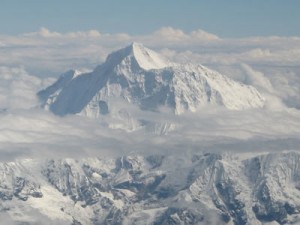
An aerial view of Mount Chomolungma (Everest). (ICT)
China’s President Hu Jintao joins the Group of Eight (G8) Summit in Heiligendamm, Germany, from Friday (June 11) to discuss a host of global issues, including working towards a common goal for curbing climate change.
Tibet, often referred to as the ‘roof of the world’ or the ‘world’s third pole’ because it contains the biggest ice fields outside of the Arctic and Antarctic, is threatened by melting glaciers and other extreme weather phenomena, the consequences of which will affect the lives of millions of people in Asia as well as those on the high plateau; Tibet is the source of the ten major rivers of Asia, which serve more than half of the earth’s population downstream. A recent report by the UN Intergovernmental Panel on Climate Change forecast that, if current trends continue, 80″ of Himalayan glaciers will be gone in 30 years.
Kai Mueller, Executive Director of ICT-Germany, said: “If China is serious in its intention to tackle climate change and address the environmental crisis, it must ensure the involvement, as opposed to the marginalisation, of Tibetan people in the stewardship of the land.
“China’s presence in Tibet for more than half a century has had devastating effects on the environment so far, particularly as a result of Beijing’s plans for fast-track economic development of the region. Deforestation, mega-projects such as the new railway to Lhasa, water shortages and hydro-power projects, unchecked effects of the extractive industry and the beginning of mass tourism are serious threats to the fragile Tibetan high-altitude environment, which matters to the whole of Asia and the rest of the world.”
China announced plans this week to spend at least 10 billion yuan ($1.3 billion) on building an ‘ecological belt’ in the Tibet Autonomous Region to address the crisis, including the ‘restoration’ of 20 million hectares of grassland, which officials say will “cushion the impact of global warming”. But this plan includes funding for the settlement of nomads and fencing of grasslands, which makes up 70″ of Tibet’s landscape. While Beijing claims that these measures protect the environment, the resettlement of Tibetan herders has been criticised by Tibetan, Chinese and Western experts for contributing to grassland degradation on Tibet’s high altitude landscape, imperilling a lifestyle that has been sustainable for centuries, and increasing poverty. Mueller said: “Far from being environmentally friendly, the consequences exemplify the damaging impact of the imposition of Chinese urban and industrial models on traditional and sustainable modes of production in rural Tibetan areas.”
ICT calls upon the G8 to press President Hu to move forward with an environmental plan for Tibet that genuinely reflects the needs and livelihoods of the Tibetan people and takes into account the fragility of the unique high-plateau environment, which is so critical to the rest of the world.
Exiled Tibetan leader the Dalai Lama has stressed the importance of global inter-dependence and personal responsibility in facing the world’s environmental crisis. At a meeting on the environment in Australia yesterday (June 5), he said: “The present generation has the moral responsibility to keep sufficient resources for future generations.”

